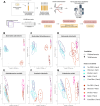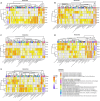In-depth characterization of a selection of gut commensal bacteria reveals their functional capacities to metabolize dietary carbohydrates with prebiotic potential
- PMID: 38441031
- PMCID: PMC11019791
- DOI: 10.1128/msystems.01401-23
In-depth characterization of a selection of gut commensal bacteria reveals their functional capacities to metabolize dietary carbohydrates with prebiotic potential
Abstract
The microbial utilization of dietary carbohydrates is closely linked to the pivotal role of the gut microbiome in human health. Inherent to the modulation of complex microbial communities, a prebiotic implies the selective utilization of a specific substrate, relying on the metabolic capacities of targeted microbes. In this study, we investigated the metabolic capacities of 17 commensal bacteria of the human gut microbiome toward dietary carbohydrates with prebiotic potential. First, in vitro experiments allowed the classification of bacterial growth and fermentation profiles in response to various carbon sources, including agave inulin, corn fiber, polydextrose, and citrus pectin. The influence of phylogenetic affiliation appeared to statistically outweigh carbon sources in determining the degree of carbohydrate utilization. Second, we narrowed our focus on six commensal bacteria representative of the Bacteroidetes and Firmicutes phyla to perform an untargeted high-resolution liquid chromatography-mass spectrometry metabolomic analysis: Bacteroides xylanisolvens, Bacteroides thetaiotaomicron, Bacteroides intestinalis, Subdoligranulum variabile, Roseburia intestinalis, and Eubacterium rectale exhibited distinct metabolomic profiles in response to different carbon sources. The relative abundance of bacterial metabolites was significantly influenced by dietary carbohydrates, with these effects being strain-specific and/or carbohydrate-specific. Particularly, the findings indicated an elevation in short-chain fatty acids and other metabolites, including succinate, gamma-aminobutyric acid, and nicotinic acid. These metabolites were associated with putative health benefits. Finally, an RNA-Seq transcriptomic approach provided deeper insights into the underlying mechanisms of carbohydrate metabolization. Restricting our focus on four commensal bacteria, including B. xylanisolvens, B. thetaiotaomicron, S. variabile, and R. intestinalis, carbon sources did significantly modulate the level of bacterial genes related to the enzymatic machinery involved in the metabolization of dietary carbohydrates. This study provides a holistic view of the molecular strategies induced during the dynamic interplay between dietary carbohydrates with prebiotic potential and gut commensal bacteria.
Importance: This study explores at a molecular level the interactions between commensal health-relevant bacteria and dietary carbohydrates holding prebiotic potential. We showed that prebiotic breakdown involves the specific activation of gene expression related to carbohydrate metabolism. We also identified metabolites produced by each bacteria that are potentially related to our digestive health. The characterization of the functional activities of health-relevant bacteria toward prebiotic substances can yield a better application of prebiotics in clinical interventions and personalized nutrition. Overall, this study highlights the importance of identifying the impact of prebiotics at a low resolution of the gut microbiota to characterize the activities of targeted bacteria that can play a crucial role in our health.
Keywords: commensal bacteria; dietary carbohydrates; metabolomics; prebiotics; transcriptomics.
Conflict of interest statement
The authors declare no conflict of interest.
Figures





Similar articles
-
Harvesting of Prebiotic Fructooligosaccharides by Nonbeneficial Human Gut Bacteria.mSphere. 2020 Jan 8;5(1):e00771-19. doi: 10.1128/mSphere.00771-19. mSphere. 2020. PMID: 31915220 Free PMC article.
-
Modulation of the human gut microbiota by dietary fibres occurs at the species level.BMC Biol. 2016 Jan 11;14:3. doi: 10.1186/s12915-015-0224-3. BMC Biol. 2016. PMID: 26754945 Free PMC article.
-
A combined metabolomic and phylogenetic study reveals putatively prebiotic effects of high molecular weight arabino-oligosaccharides when assessed by in vitro fermentation in bacterial communities derived from humans.Anaerobe. 2014 Aug;28:68-77. doi: 10.1016/j.anaerobe.2014.05.007. Epub 2014 Jun 4. Anaerobe. 2014. PMID: 24905430
-
Prebiotics and the Human Gut Microbiota: From Breakdown Mechanisms to the Impact on Metabolic Health.Nutrients. 2022 May 17;14(10):2096. doi: 10.3390/nu14102096. Nutrients. 2022. PMID: 35631237 Free PMC article. Review.
-
Designing future prebiotic fiber to target metabolic syndrome.Nutrition. 2014 May;30(5):497-502. doi: 10.1016/j.nut.2013.08.013. Epub 2013 Oct 2. Nutrition. 2014. PMID: 24262515 Review.
Cited by
-
Gut microbiota: a new target for the prevention and treatment of insomnia using Chinese herbal medicines and their active components.Front Pharmacol. 2025 May 6;16:1572007. doi: 10.3389/fphar.2025.1572007. eCollection 2025. Front Pharmacol. 2025. PMID: 40395724 Free PMC article. Review.
-
Human Gut Microbiome: A Connecting Organ Between Nutrition, Metabolism, and Health.Int J Mol Sci. 2025 Apr 26;26(9):4112. doi: 10.3390/ijms26094112. Int J Mol Sci. 2025. PMID: 40362352 Free PMC article.
-
Positive nutritional selection of adults with healthy lifestyle and high daily fiber consumption for the isolation of beneficial intestinal bacteria: The iTARGET cohort study protocol.MethodsX. 2025 Mar 17;14:103268. doi: 10.1016/j.mex.2025.103268. eCollection 2025 Jun. MethodsX. 2025. PMID: 40224142 Free PMC article.
-
From gut to joint: the protective impact of Eubacterium rectale on rheumatoid arthritis.Front Immunol. 2025 Jul 25;16:1607804. doi: 10.3389/fimmu.2025.1607804. eCollection 2025. Front Immunol. 2025. PMID: 40787457 Free PMC article.
-
Relationship between feed efficiency and gut microbiota in laying chickens under contrasting feeding conditions.Sci Rep. 2024 Apr 8;14(1):8210. doi: 10.1038/s41598-024-58374-3. Sci Rep. 2024. PMID: 38589474 Free PMC article.
References
-
- Gibson GR, Hutkins R, Sanders ME, Prescott SL, Reimer RA, Salminen SJ, Scott K, Stanton C, Swanson KS, Cani PD, Verbeke K, Reid G. 2017. Expert consensus document: the international scientific association for probiotics and prebiotics (ISAPP) consensus statement on the definition and scope of prebiotics. Nat Rev Gastroenterol Hepatol 14:491–502. doi:10.1038/nrgastro.2017.75 - DOI - PubMed
-
- Biscarrat P, Bedu-Ferrari C, Langella P, Cherbuy C. 2024. Pulses: a way to encourage sustainable fiber consumption. Trends Food Sci 143:104281. doi:10.1016/j.tifs.2023.104281 - DOI
MeSH terms
Substances
LinkOut - more resources
Full Text Sources
Medical
